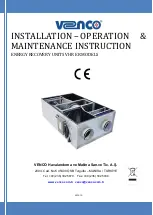
Pág. 47
5.5.8 SMAW (DC)
In SMAW mode, 4 parameters that can be adjusted directly and 1 parameter that can only be adjusted through
programming are available for this machine. Describe them as below.
Current (I2):
This is the welding current when arc is burning, and users can set it according to their own technical
requirements.
Arc force:
It refers to the ascending slope of the current in short circuit, and it is set as the amperage increased
per millisecond in this machine. The current will ascend from the preset value by this slope after short circuit
occurs. (E.g. When the preset current is 100A and the arc force is 20, the current will be 200A 5ms after short
circuit occurs.) If it is still under short circuit when the current increases to the allowable maximum value 250A,
the current will not ascend any more. If the short circuit status lasts for 0.8s or more, the machine will enter into
electrode sticking process: to wait the disconnection of the electrode under low current. Arc force should be set
according to the electrode diameter, preset current and the technical requirement. If the arc force is big, the
molten drop can be transferred quickly, and electrode sticking seldom occurs. However, too big arc force may
lead to excessive spatter. If the arc force is small, there will be little spatter, and the weld bead will be shaped
well. However, too small arc force may lead to soft arc and electrode sticking. Therefore, the arc force should be
increased when welding with thick electrode under low current. In general welding, the arc force may be set at
5~50.
Arc ignition current (I1) and arc ignition time (T1):
Arc ignition current is the output current of the machine
when the arc is ignited. Arc ignition time is the time the arc ignition current lasts. When in non-contact ignition
mode, neither parameter makes sense. When in high current ignition mode, the arc ignition current is generally
1.5~3 times the welding current, and the arc ignition time is 0.02~0.05s. When in low current ignition mode, the
arc ignition current is generally 0.2~0.5 times the welding current, and the arc ignition time is 0.02~0.1s.
Operation hints
Arc ignition modes in SMAW
Low current arc ignition:
This can be also called lift/soft arc ignition. Set the arc ignition current (I1) to be
a value lower than I2 and the machine will enter into low current arc ignition mode. Touch the workpiece
with the electrode, and lift the electrode to the normal position to weld after arc is ignited.
High current arc ignition:
This can be also called contact/thermal arc ignition. Set the arc ignition current
(I1) to be a value not lower than I2 and the machine will enter into high current arc ignition mode. Touch
the workpiece with the electrode, and normal welding can be carried out without lifting the electrode.
Arc breaking voltage (U1):
This parameter is used for setting the arc breaking voltage during welding. It is
specially designed to meet the requirement in HF intermittent welding, and its resolution is 0.1V. The arc breaking
voltage indicates the maximum allowable arc voltage during welding, that is to say, welding can be continued
when the arc voltage is lower than U1, or else welding will stop immediately. This parameter can not be simply
adjusted like other parameters, and should be adjusted by the following method.
Note:
t0
—Standby: No welding current; output voltage is the no-load voltage.
t1
—Arc ignition: Welding current is arc ignition current (I1).
t3
—Arc burning: Welding current is the preset current (I2).
t4
—Short-circuit transfer: Welding current is the short-circuit transfer current (I3).
Summary of Contents for Smart 310 TIG Pulse AC/DC
Page 2: ......
















































